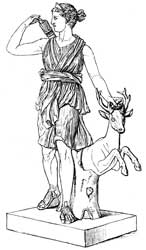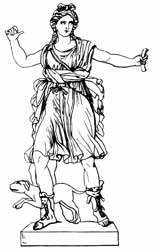Diana

An original Italian divinity, whom the Romans completely identified with the Greek Artemis. The earliest trace of her worship occurs in the story about Servius Tullius, who is said to have dedicated to her a temple on the Aventine, on the ides of Sextilis (August). It is added that, as Diana was the protectress of the slaves, the day on which that temple had been dedicated was afterwards celebrated every year by slaves of both sexes, and was called the day of the slaves (dies servorum).1 Besides that day of the slaves, we hear of no festival of Diana in early times, which may be accounted for by supposing that either she was a divinity of inferior rank, or that her worship had been introduced at Rome without being sanctioned or recognized by the government, that is, by the ruling patricians.

The former cannot have been the case, as the goddess was worshiped by the plebeians and the Latins as their patron divinity; for a tradition related that the plebeians had emigrated twice to the Aventine, where stood the temple of Diana;2 and the temple which Servius Tullius built on the Aventine was founded for the benefit of the Latin subjects, who assembled and sacrificed there every year.3 The Sabines and Latins, who formed the main stock of the plebeians, were thus in all probability the original worshipers of Diana at Rome. We know that the Aventine was first occupied by the conquered Sabines who were transplanted to Rome,4 and as it is stated that shortly before the decemviral legislation the Aventine was assigned to the plebeians, and that the law ordaining this assignment was kept in the temple of Diana,5 it seems clear that Diana's worship was introduced at Rome by the Sabines and Latins on their becoming plebeians, and that she was worshiped by them in particular without the state taking any notice of her, or ordaining any festival in honor of her. Varro6 moreover expressly attests, that the worship and name of Diana had come from the Sabines.
Now, as the religion of the Latins and Sabines did not differ in any essential point from that of the Romans, we may ask what Roman divinity corresponded to the Sabine or Latin Diana? Diana loved to dwell in groves and in the neighborhood of wells; she inspired men with enthusiasm and madness; she dreaded the very sight of male beings so much, that no man was allowed to enter her temple, and she herself remained a virgin;7 and these characteristics at once showed a striking resemblance between Diana and Feronia or Fauna Fatua. This circumstance, and the fact that Diana was the goddess of the moon, also render it easy to conceive how the Romans afterwards came to identify Diana with the Greek Artemis, for Fauna Fatua bore the same relation to Picus and Faunus that Artemis bore to Apollo.
❧
Iconography
Diana is represented as a huntress, with a short skirt and a quiver, accompanied by a hind. Well-known is the Diana of Gabii at the Louvre (indicating Praxiteles, fourth century BCE). The Diana of Versailles, possibly by Leochares (fourth century BCE), is also located at the Louvre. It shows the goddess as a speedy huntress, with raised garb and accompanied by a deer. Diana and her Greek counterpart Artemis have been painted by Coreggio, Rubens, Boucher, Corot, and sculpted by Goujon, Houdon, Milles, and Falquières.
References
Notes
- Festus, s.v. servorum dies; Plutarch. Roman Questions, 100; Martial, xii, 67.
- Livy. The History of Rome ii, 32; iii, 51, 54; Sallust. Bellum Iugurthinum, 31.
- Dionysius of Halicarnassus. Roman Antiquities iv, 26; comp. Livy. The History of Rome i, 45; Plutarch. Roman Questions, 4.
- Servius on Virgil's Aeneid vii, 657; Dionysius of Halicarnassus. Roman Antiquities iii, 43.
- Dionysius of Halicarnassus. Roman Antiquities x, 32; Livy. The History of Rome iii, 54.
- On the Latin Language v, 74.
- Horace. Epistles ii, 1.454; Plutarch. Roman Questions, 3; Festus, s.v. Juvenilia; Augustine. City of God vii, 16.
Sources
- Aken, Dr. A.R.A. van. (1961). Elseviers Mythologische Encyclopedie. Amsterdam: Elsevier.
- Bartelink, Dr. G.J.M. (1988). Prisma van de mythologie. Utrecht: Het Spectrum.
- Hartung, J.A. Die Religion der Römer. Vol. 2, p. 207 ff.
- Niebuhr. History of Rome, i, p. 367 ff.
- Smith, William. (1870). Dictionary of Greek and Roman Biography and Mythology. London: Taylor, Walton, and Maberly.
This article incorporates text from Dictionary of Greek and Roman Biography and Mythology (1870) by William Smith, which is in the public domain.